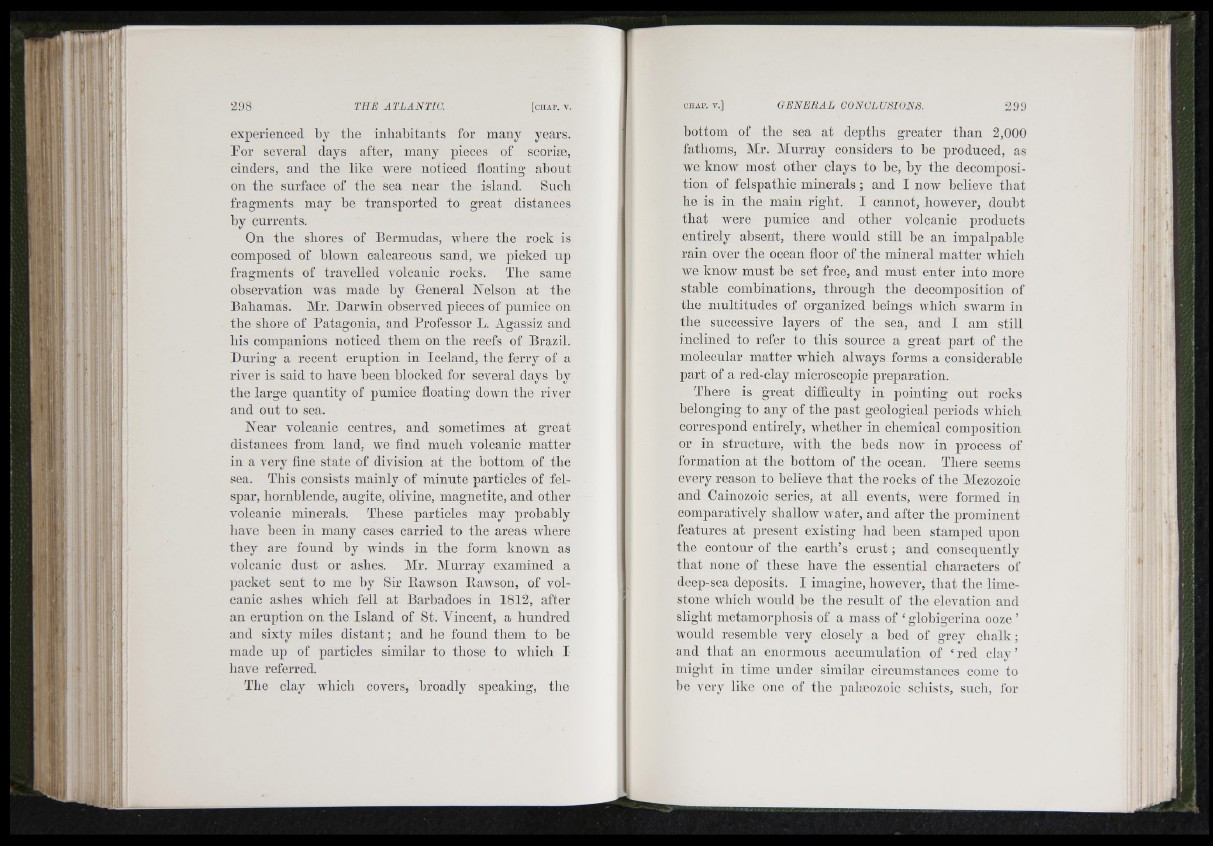
A
I
!
■if 11
' ■ i * !!
I f ll;i.
I i
■‘ki
: ‘Gill
1 i to'h
to
fi'il " S
4: i - t o:
• i G.G!’
experienced by tbe inbabitants for many years.
For seA'eral days after, many pieces of scoriæ,
cinders, and tbe like AA'ere noticed floating abont
on tbe surface of tbe sea near tbe island. Sncb
fragments may be transported to great distances
by currents.
On tbe shores of Bermudas, Avliere the rock is
composed of hloAV'u calcareous sand, aa'o picked up
fragments of traA'elled A'olcanic rocks. The same
ohserA'ation AA'as made by General Nelson a t the
Bahamas. Mr. DarAvin ohseiwed pieces of pumice on
the shore of Patagonia, and Professor L. Agassiz and
his companions noticed them on the reefs of Brazil.
During a recent eruption in Iceland, the ferry of a
riA'er is said to have heen blocked for seA'eral days hy
the large quantity of pumice floating down the river
and out to sea.
Near volcanic centres, and sometimes at great
distances from land, we find much volcanic matter
in a A'ery fine state of division at the bottom of the
sea. This consists mainly of minute particles of felspar,
hornblende, augite, olivine, magnetite, and other
A'olcanic minerals. These particles may probably
bave been in many cases carried to tbe areas Avhere
tbey are found by winds in tbe form known as
volcanic dust or asbes. Mr. Murray examined a
packet sent to me by Sir Rawson Rawson, of volcanic
asbes wbicb fell at Barbadoes in 1812, after
an eruption on tbe Island of St. Vincent, a Imndred
and sixty miles distant ; and be found tbem to be
made up of particles similar to tbose to wbicb I
liaA'e referred.
Tbe clay Avbicb covers, broadly speaking, tbe
bottom of tbe sea at depths greater tban 2,000
fatlioms, Mr. Murray considers to be produced, as
we know most other clays to he, by the decomposition
of felspathic minerals ; and I now believe th a t
he is in the main right. I cannot, however, donht
th at were pumice and other volcanic products
entirely absent, there Avould still be an impalpable
rain over the ocean floor of the mineral matter Avhich
Ave knoAV must be set free, and must enter into more
stable combinations, through the decomposition of
the multitudes of organized beings which sAvarm in
the successive layers of the sea, and I am still
inclined to refer to this source a great pa rt of tfie
molecular matter which always forms a considerable
part of a red-clay microscopic preparation.
Tbere is great difficulty in pointing out rocks
belonging to any of tbe past geological periods Avbicb
correspond entirely, Avbetber in chemical composition
or in structure, AA'ith the beds iio a v in process of
formation at the bottom of tbe ocean. There seems
every reason to believe tb a t tbe rocks of tbe Mezozoic
and Cainozoic series, at all events, Avere formed in
comparatively sballoAV Avater, and after tbe prominent
features at present existing iiad been stamped upon
tbe contour of tbe earth’s c ru s t; and consequently
tb a t none of tbese have tbe essential cliaracters of
deep-sea deposits. I imagine, boAvever, tb a t tbe limestone
AA'bicb AA'onld be tbe result of tbe elevation and
slight metamorphosis of a mass of ‘ globigerina ooze ’
would resemble very closely a bed of grey c h a lk ;
and tb a t an enormous accumulation of ‘ red c lay ’
might in time under similar circumstances come to
l)c very like one of tbe pabcozoic sclfists, such, for